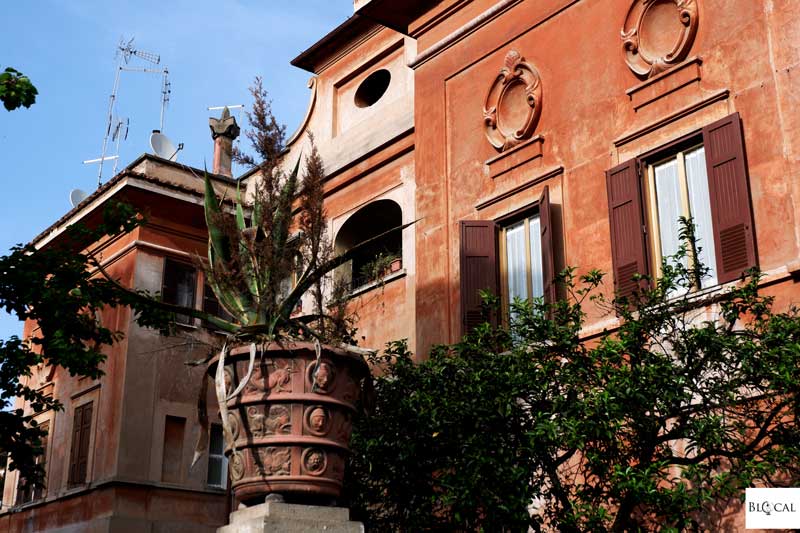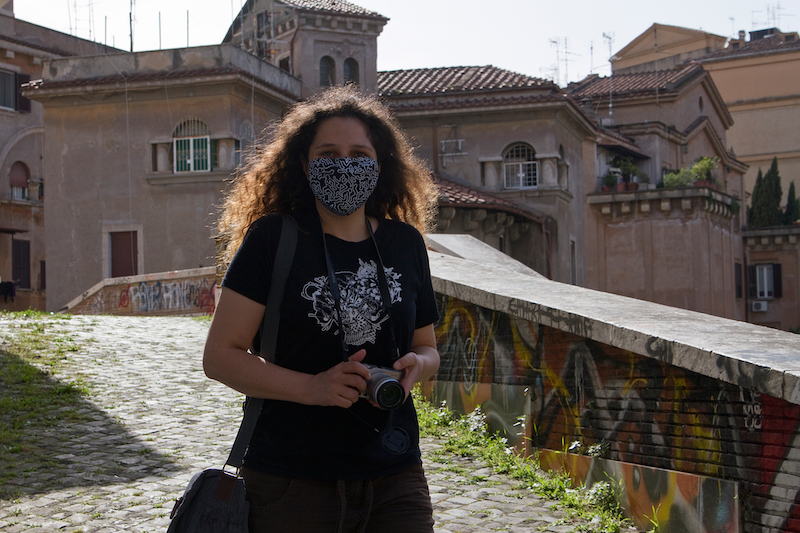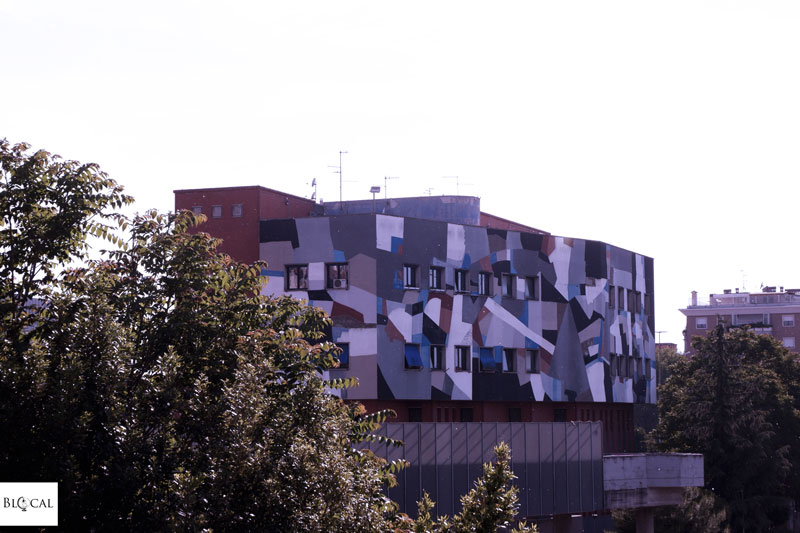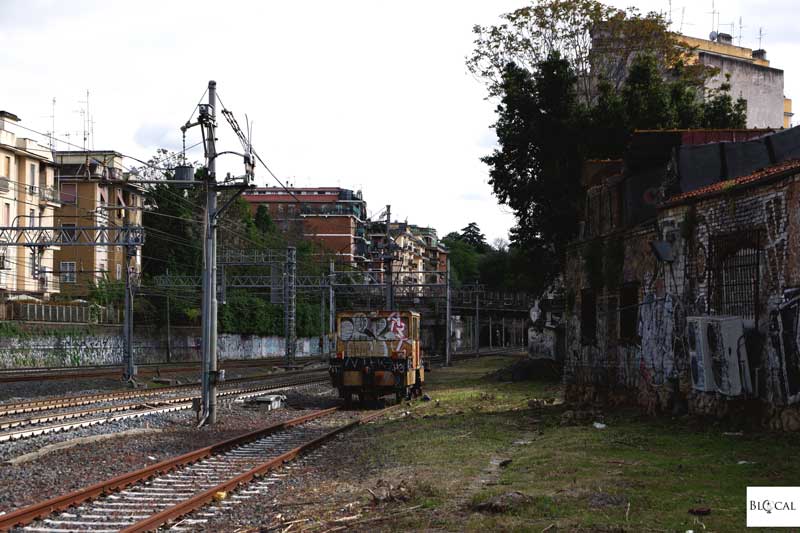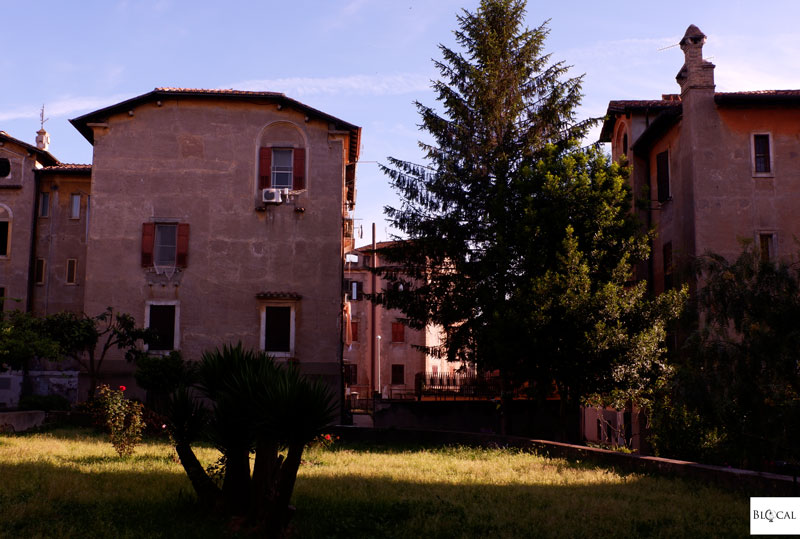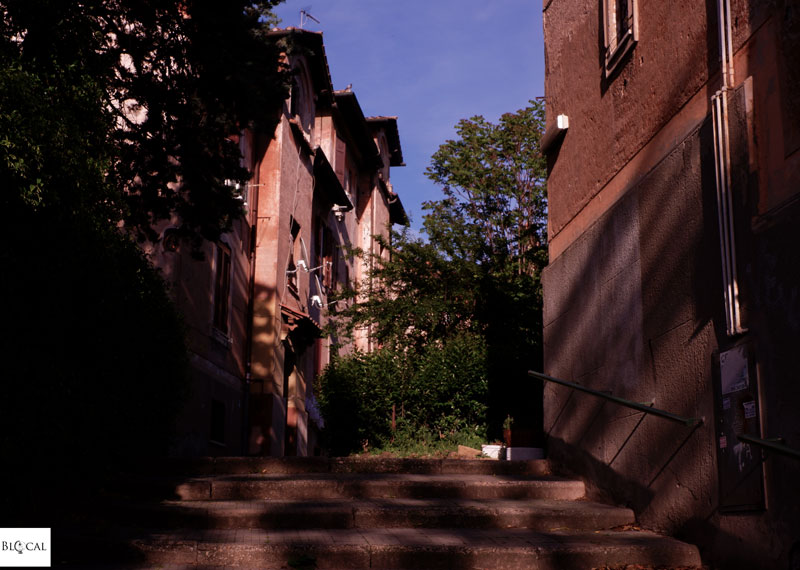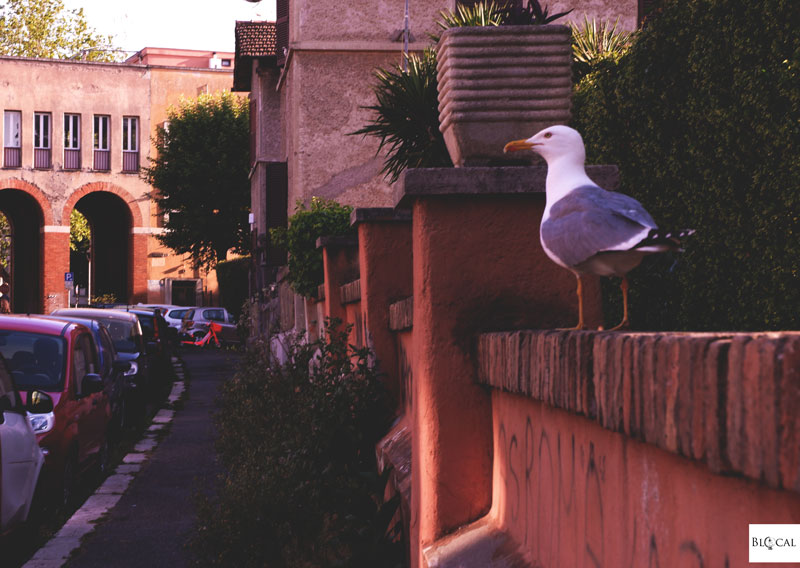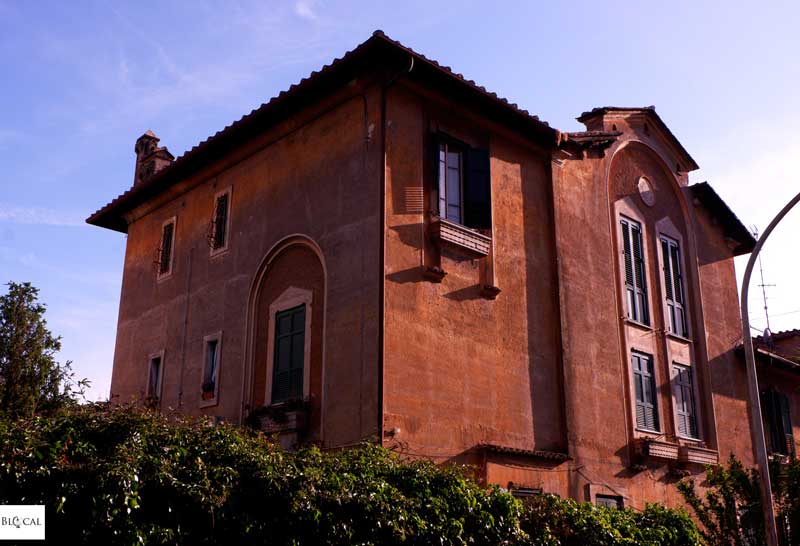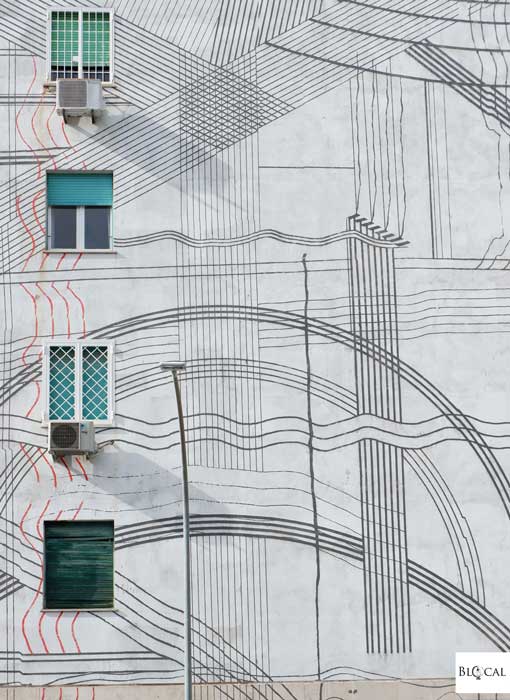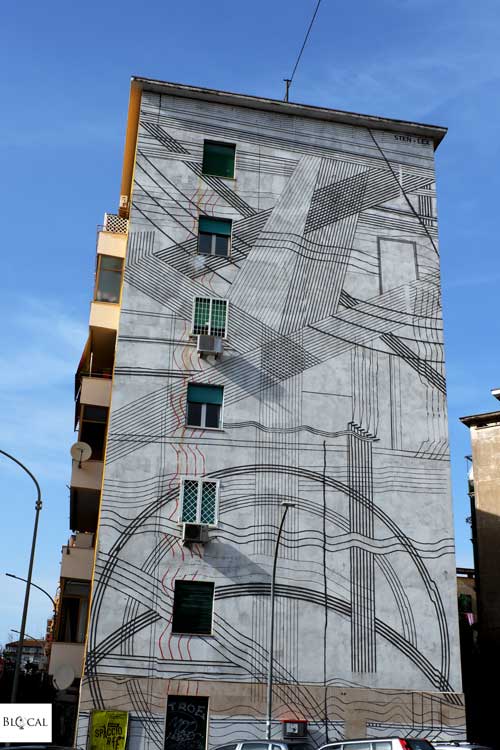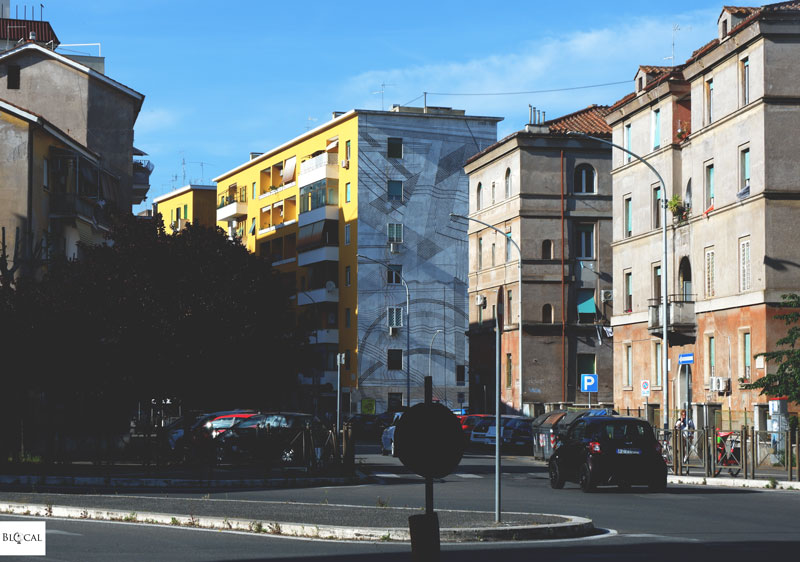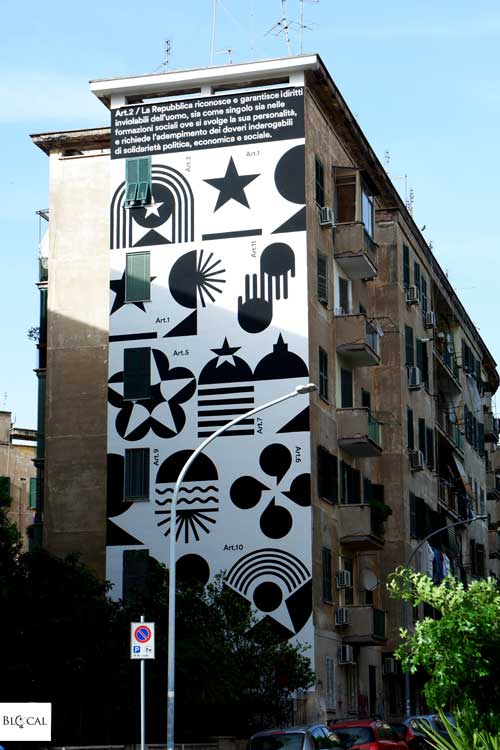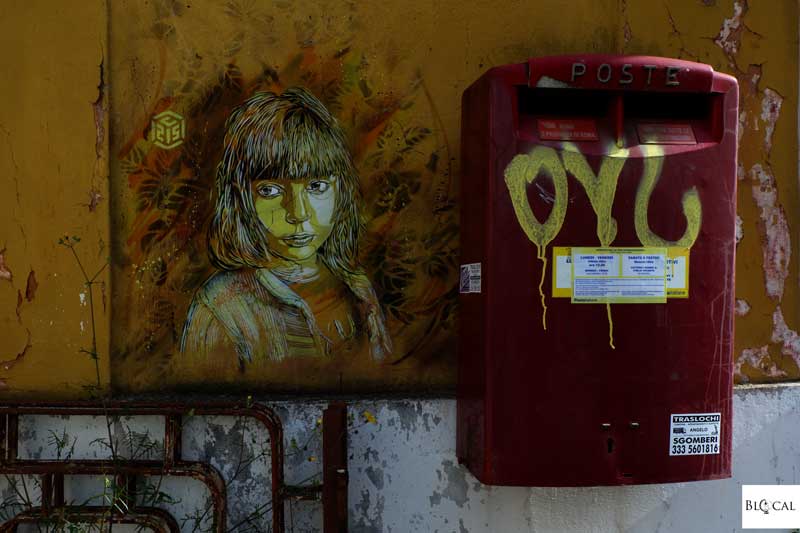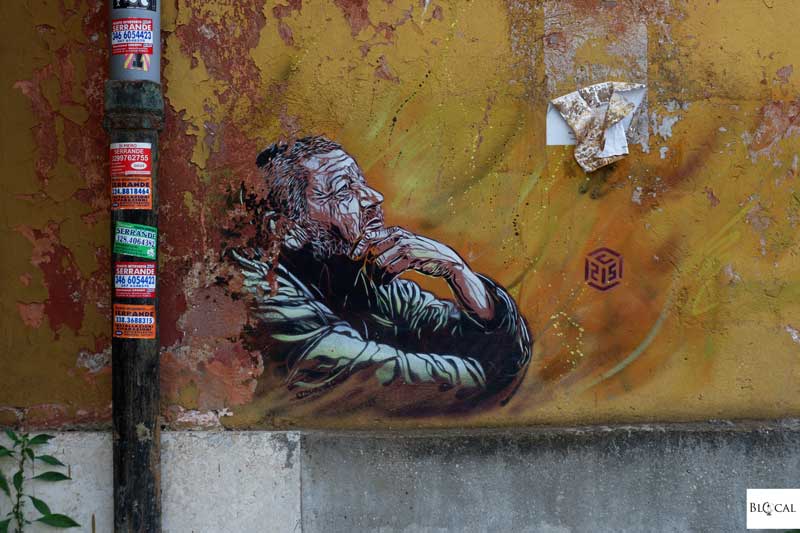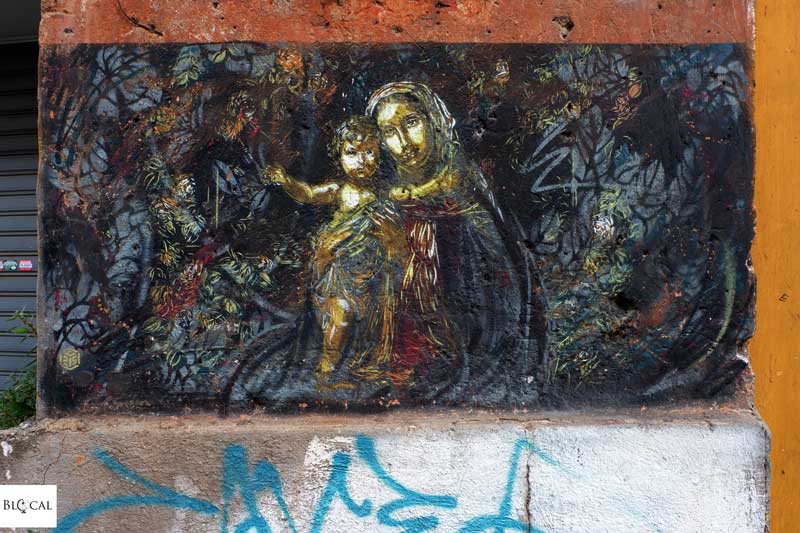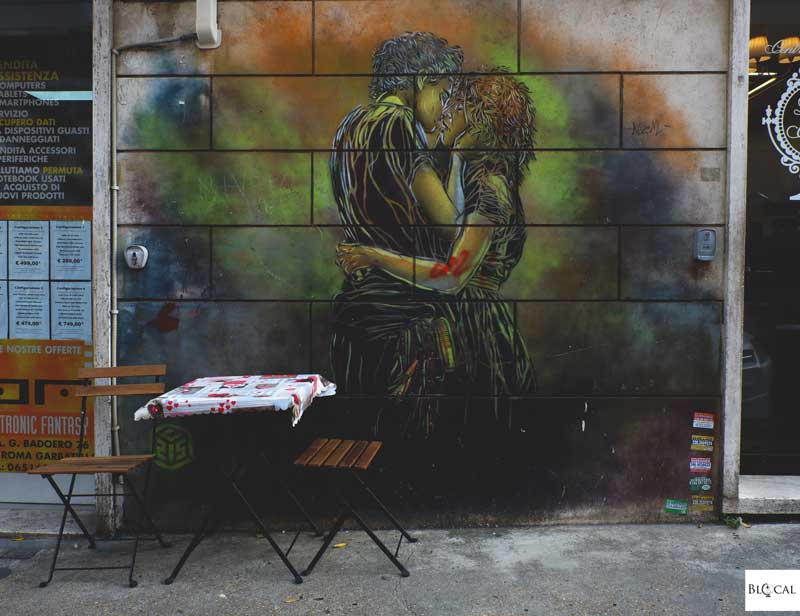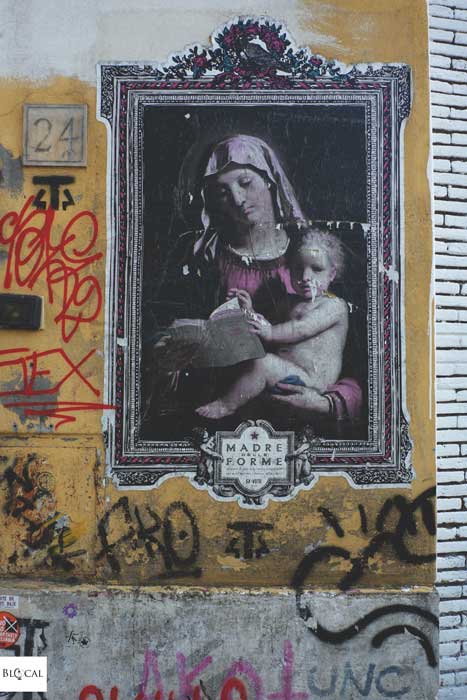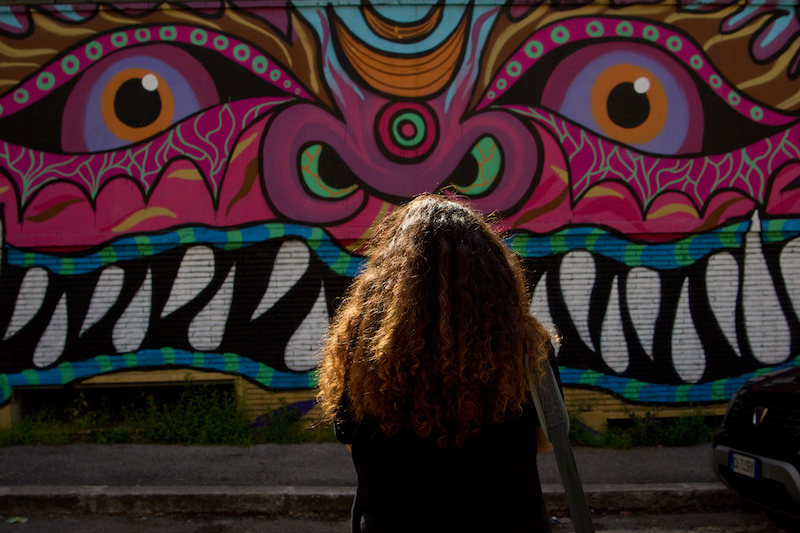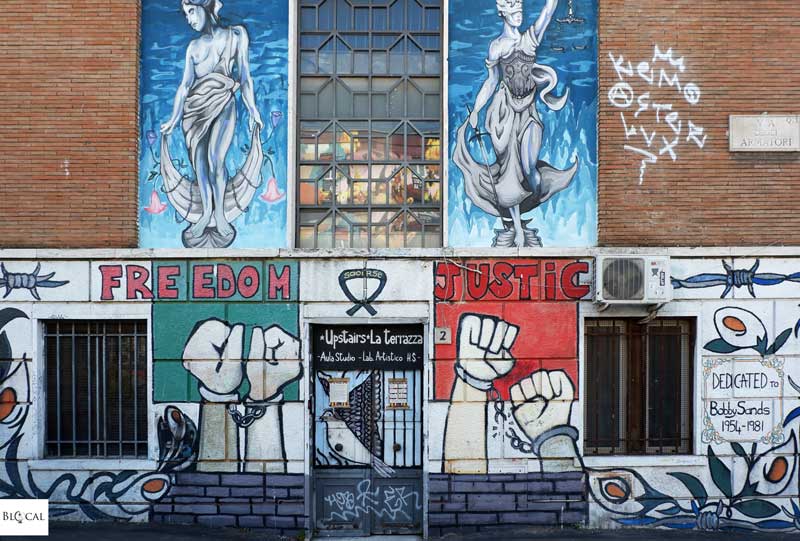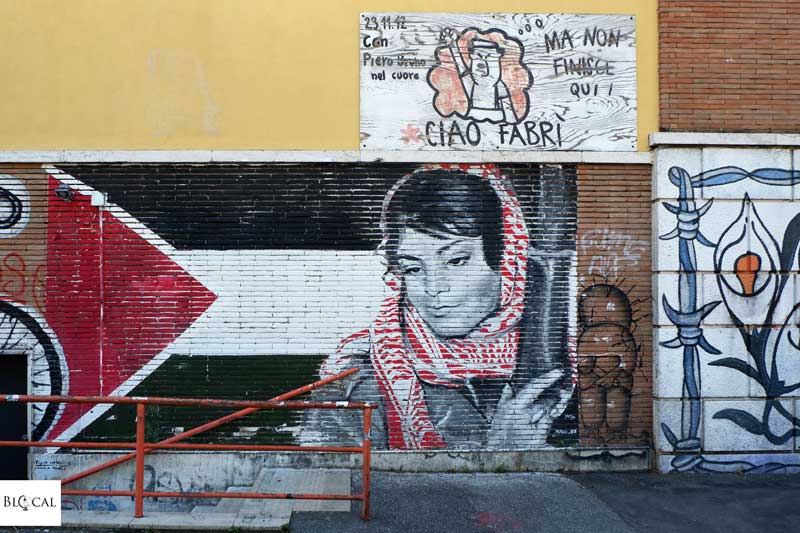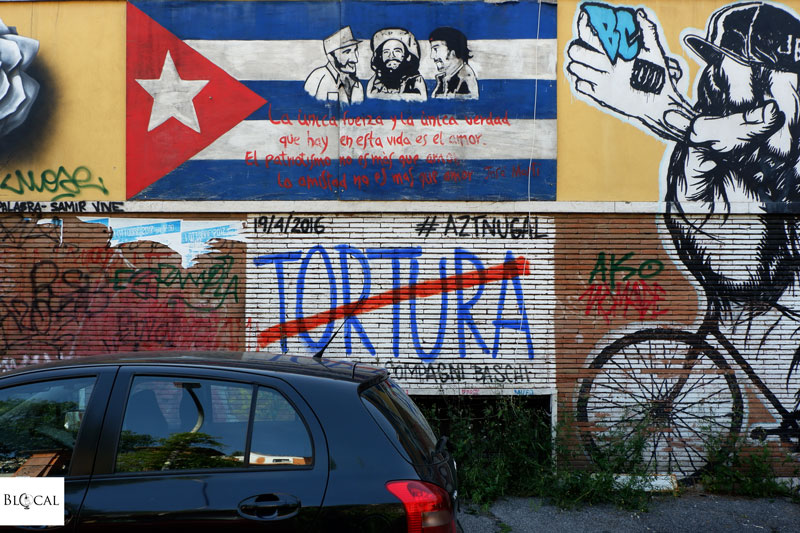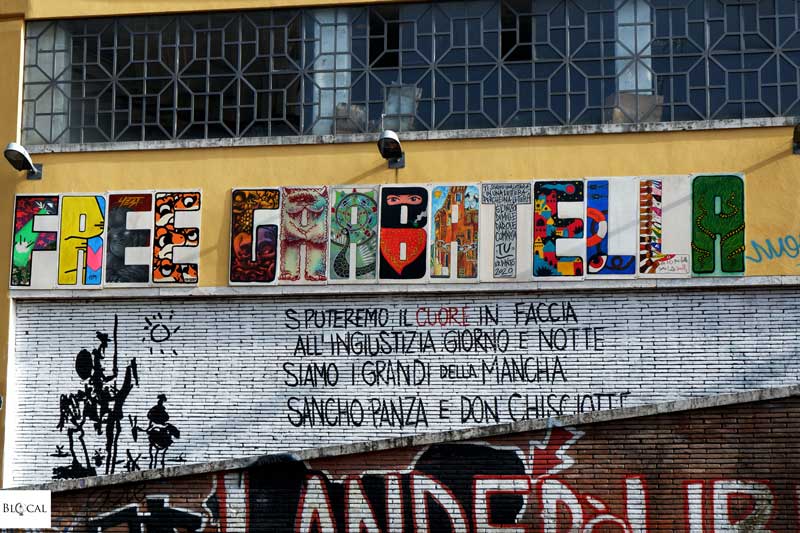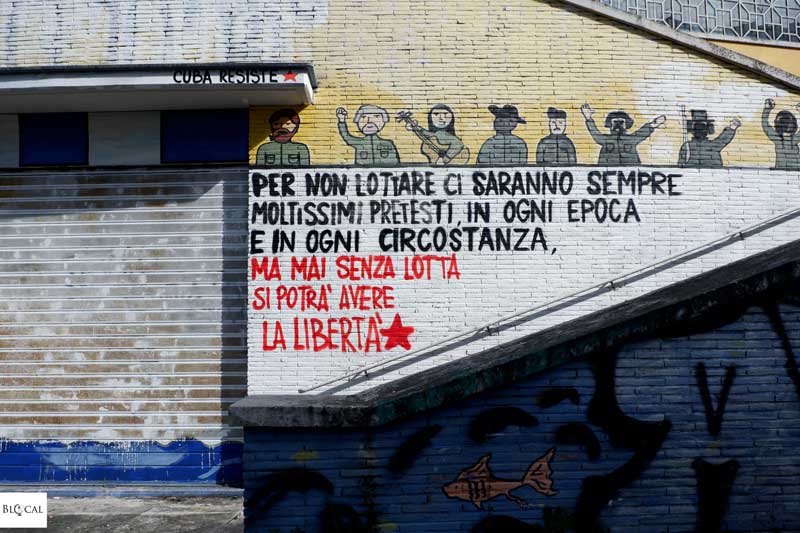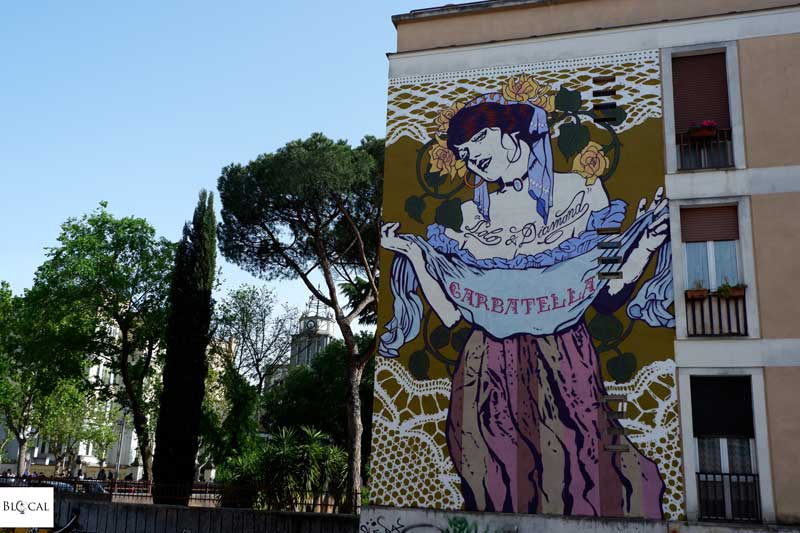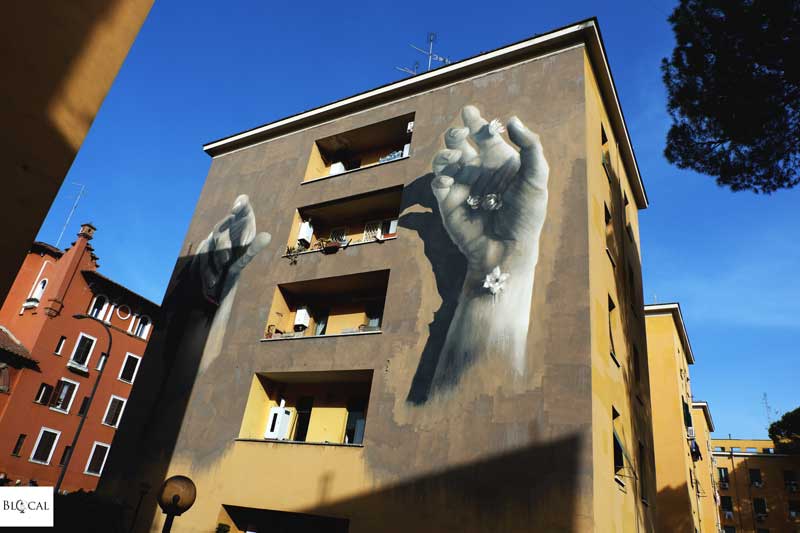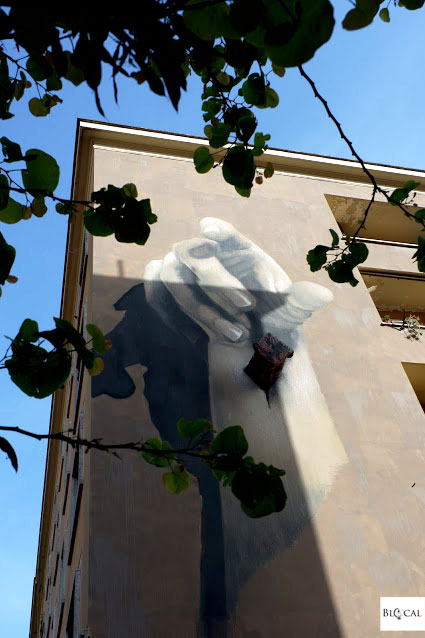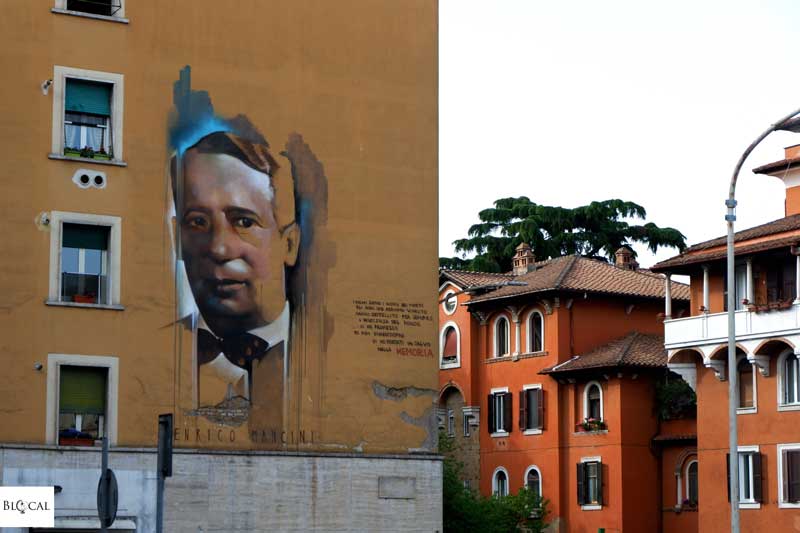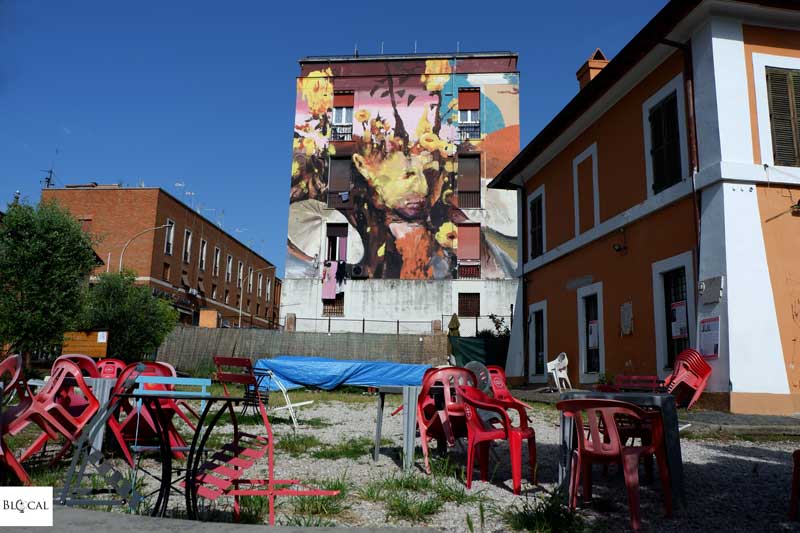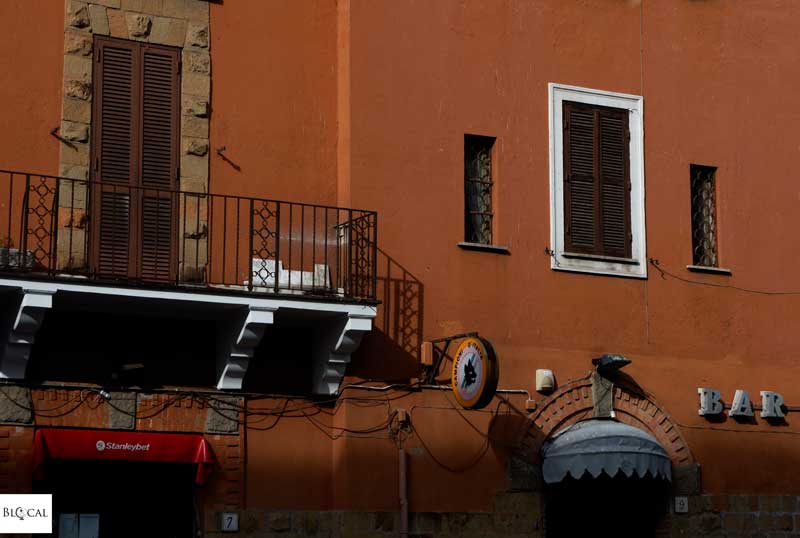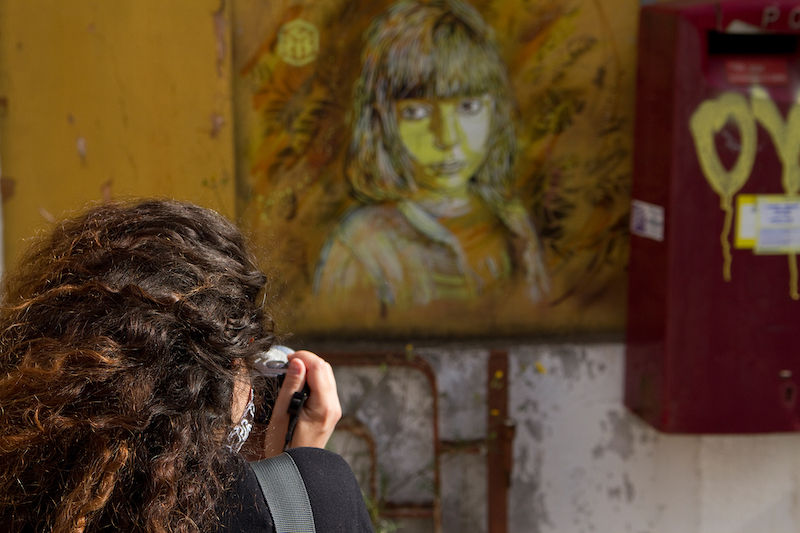Even without street art, Garbatella would remain one of the most beautiful neighbourhoods of Rome.
Officially founded on 18 February 1920, last year Garbatella celebrated its 100th anniversary. Famous for its typical property lots which welcomed many families that were evacuated from the historic city centre during Italy’s fascist years, the neighbourhood is preserved as an oasis of peace and is still known for its authentic folk spirit.
Instead of the historic entrance to Garbatella at Piazza Brin, the starting point of this walk is the new Settimia Spizzichino bridge, which links Via Ostiense to the ‘new’ Garbatella.
Thus – leaving behind us the famous mural by Blu in Via Ostiense – we cross the bridge and, on the right, we see a large abstract work that the German artist Clemens Behr painted on the building of ATAC (the municipality’s transport company) in 2014 on the occasion of the festival Avanguardie Urbane.
The geometric forms of Behr’s artwork (whose colours intentionally match those of the surrounding landscape) are the fruit of a common evolution that many graffiti writers go through – tired as they are of the repetitiveness and rigidity of the style conventions of graffiti, they push their style towards freer forms, and at times all the way towards abtract art.
- Read also: “Street Art in Rome: A Guide to Ephemeral Art in Italy’s Eternal City” the ultimate travel guide to the top 26 neighborhoods to find street art in Rome, with handpicked local tips to eat, drink and shop in Rome like a local.
In any case, there is no lack of classic graffiti in Garbatella. In fact, it can be admired looking down from this very bridge, as ‘bombed’ trains of metroline B pass by underneath.
Once on the other side of the bridge, we take Circonvallazione Ostiense, venturing towards the historic part of Garbatella, with its dwellings managed by ATER, the company for public housing in the municipality of Rome.
Modelled on the garden city suburbs that were popular in England in the early 20th century, Garbatella is famous for its lotti, small clusters of apartments that are characterised by public spaces shared among the families who live there: vegetable gardens, courtyards with washbasins, drying racks, workshops and gardens where children can play unhindered.
- Read also: Garbatella is a Poetic Neighbourhood
Just before the entrance to the lotti, we find one of the first large murals in Garbatella, created in 2013 during the Outdoor festival.
‘Passaggio’ (‘Passage’ or ‘Transition’) was painted by Sten & Lex in Via Caffaro on the same wall where, in 2010, this same duo created a huge paste up with the face of the legendary AS Roma attacking midfielder Francesco Totti, juxtaposed to a wolf.
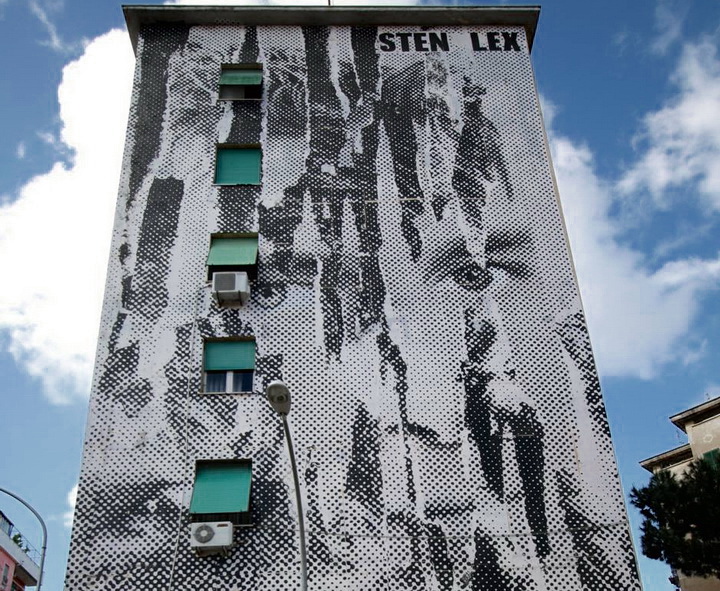
Within merely three years, the style of the duo had changed remarkably and now, the same building in Garbatella sports a geometric and almost monochromatic work whose lines, stripes and circles follow one another as though they represent a melody on sheet music.
This mural was the first in Rome to be produced on the basis of crowdfunding, an indication of the extent to which street art is admired and desired by inhabitants of modern cities.
Despite the fact that the first editions of Outdoor took place in the area comprising Ostiense, Marconi and Garbatella, this mural by Sten & Lex is the only work of street art in Garbatella from those years that is still around.
In 2021 a second, monochromatic mural appeared next to it. Created by Greg Jager, together with a collective made of a designer, an art director and a psychologist (respectively: Giampiero Quaini, Paola Manfroni and Federica Micale), this second mural represents the first 12 articles of the Italian Constitution through 12 different symbols.
Most notably, Garbatella is rich of many unsanctioned artworks by famous European street artists such as Alice Pasquini, Space Invader and C215 among others.
The well-known French artist Christian Guemy (C215) has been particularly productive in the streets of Garbatella, creating highly detailed stencils that depict cats, women, homeless people and even his daughter Nina. One of his works, situated in Via Badoero, is unusually large in size for C215’s standards.
One artist who creates paste ups – simultaneously both sacred and profane in nature − and is very active in the southern parts of Rome including Garbatella, is Ex Voto Fecit.
His works can be found, for example, at the vegetable market (‘Madre delle Forme’, which is a madonna who reads Albert Camus) and at the squat community centre called Casetta Rossa (‘Divina Madre della Resistenza’ meaning ‘Divine Mother of the Resistance’, a figure whose appearance is halfway between that of the Madonna and that of Che Guevara). From the (semi)sacred we move on to the political. Garbatella is home to one of the best known squat community centres in Rome: CSOA La Strada, whose walls and roof are covered with street art.
The roof features three niches that have been decorated by Brogi, Groove and Gojo and two larger interventions that have been created by Detshorore and Francesco Pogliaghi. The latter has painted a scene of urban guerrilla warfare, inspired by the banlieus of Paris, as seen in the film La Haine.
Many of the graffiti and street art pieces on the walls of this centre relate to the struggle for freedom and independence, in the past and in the present, from Kurdistan to Northern Ireland and from Palestine to Cuba.
At the beginning of 2020, before the coronavirus outbreak, there was renewed interest in street art in Garbatella, courtesy of the fourth edition of the festival Muri Sicuri, which came to an end at the start of the coronavirus-induced lockdown. Because of these exceptional circumstances, however, the newest murals in the area are still relatively unknown, even among Romans.
In Via Passino, Flavio Solo and Diamond have created a mural called ‘Oh my darling Clementine’, a portrait in liberty style (the Italian variant of Art Nouveau) of Clementina Eusebi, the lady this neighbourhood was named after.
The origin of the name ‘Garbatella’ was clarified following the discovery of a document from 1823 which lists the members of the family Cascapera, the owners of a restaurant of the same name in Via degli Argonauti, also knowns as the ‘restaurant of garbatella’. The list of names include that of Maddalena Garbata, the mother of Clementina who was indeed also called, ‘Garbatella’.
The second mural created during the fourth edition of Muri Sicuri is in Via Fincati and was painted by the Italian-Venezuelan artist Luis Gomez de Teran.
‘Preghiera al Tramonto’ (‘Prayer at Sunset’) recalls the earthquake that hit L’Aquila in 2009, an event that destroyed this town some 90 kilometres east of Rome and that has been a source of inspiration for Muri Sicuri. Gomez compares the outer core motions of the earth – whose crust at times splits open and then stabilises – to the changes in the life of man who, like nature, overcomes hardships and reestablishes himself to restart life.
The two hands tell the story of the transition from suffering to resurgence. The suffering is represented by the religious symbol of the nail, an actual sculpture that has been affixed to the wall to recall the torment of Christ, while the white flower buds − symbol of nature that is reborn every spring − stand for his uprising.
As 2020 marked Garbatella’s centenary, another street artist was called in to celebrate an important aspect of the neighbourhood: its antifascist past.
In Piazza Bartolomeo Romano, Francesco Pogliaghi has portrayed Enrico Mancini, a partisan who was executed in the Ardeatine massacre, a retaliation mass killing carried out in Rome on 24 March 1944 by German occupation troops.
Finally, the Philippines-born artist Jerico, who grew up in Garbatella, created an artwork close to Viletta Social LAB. Titled ‘Supernova’, this latest mural in Garbatella represents, by way of Jerico’s typical brush strokes, the main characteristic of a supernova (i.e. the explosion of a star): the release of great amounts of energy.
Garbatella is worth a visit not only for its magnificent street art, but also to experience first hand the charm of a truly unique neighbourhood of Rome which has managed to retain its authentic folk spirit over time.
That’s all folks!
Don’t forget to join up my monthly newsletter about street art, graffiti, travel and life for more ;)
Find these murals and more local tips in my Rome Google map
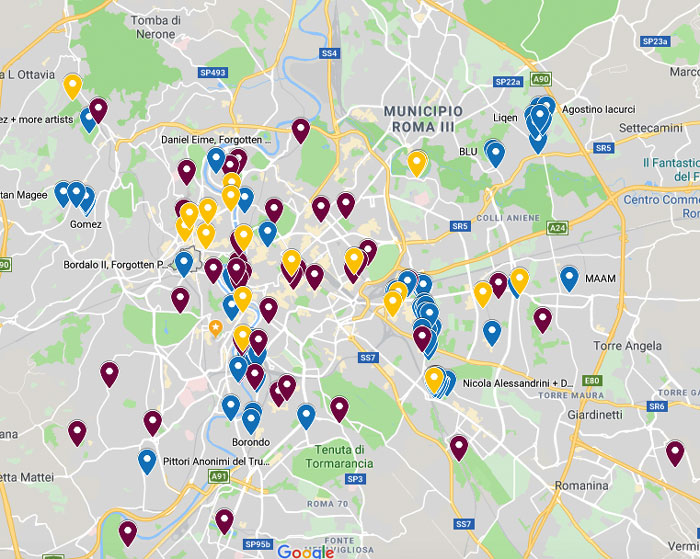
Thanks to Daniel De Jongh for the translation!
